More than 1,200 British coastal landfill sites are at risk from erosion with some already spilling waste onto beaches – and they may be the source of bizarre plastic ‘pebbles’ littering the shore
- Powerful storms and rising sea levels are accelerating erosion of the UK coast
- This is turning these once-hidden coastal landfill sites into pollution time bombs
- Researchers believe that these sites present a ‘significant contamination risk’
- A landfill site on the Thames Estuary is already dumping its load into the water
More than 1,200 British coastal landfill sites are at risk from erosion — with some already spilling waste onto beaches and into the sea.
Powerful storms and rising sea levels mean that a lot more of this once-hidden waste could be exposed — creating a pollution time bomb, expert Mark Stratton warns.
These leaking landfills may also be the source of the bizarre plastic ‘pebbles’ which have found found littering the UK shoreline.
Experts think these lumps of plastic — which float in water — are formed from burnt plastic waste dating back to the 1980s and earlier.
Scroll down for video
More than 1,200 British coastal landfill sites are at risk from erosion — and some are already spilling their waste and bizarre plastic ‘pebbles’ onto beaches. Pictured, a landfill site on the Thames Estuary is already falling out of the cliff-face
‘One of the biggest risks of doing nothing at these sites is that the defences will fail and you’ll potentially have former landfill either eroding out onto the foreshore or leaching into the water,’ Mr Stratton told BBC Inside Out South West.
‘Alongside that there’s a potential impact on human health depending on what’s in the sites,’ he added.
In a few locations — such as in Essex — erosion is already eating away at the sides of landfill sites, exposing decades-worth of human detritus to the sea, Mr Stratton said.
This could lead to dangerous pollutants — as well as plastics such as microbeads and microfibers — leaking out into the marine environment.
Research published last year by experts from the Queen Mary University of London found that the contents of such sites constituted a ‘significant contamination risk’.
The UK Government is currently reviewing coastal and flooding erosion policy — including what to do with defunct landfill sites.
In a few locations — such as in Essex — erosion is already eating away at the sides of landfill sites, exposing decades-worth of human detritus to the sea, Mr Stratton said
Powerful storms and rising sea levels mean that a lot more of this once-hidden waste could be exposed — creating a pollution time bomb, expert Mark Stratton, pictured, warns
Leaking landfills may also be the source of the bizarre plastic ‘pebbles’ which have found found littering the UK shoreline. Experts think these lumps of plastic — which float in water — are formed from burnt plastic waste dating back to the 1980s and earlier
‘We’re on a journey in terms of raising the profile of the issue but what we don’t have at the moment is a funding mechanism that directly deals with coastal contamination from former landfill sites,’ Mr Stratton explained.
‘The current funding mechanism is focused towards the protection of homes from flooding and erosion.
‘So where you have these coastal sites with very limited development behind them it’s very difficult to justify the funding.’
‘We’ve been lobbying for change for a number of years to try and broaden out what the funding can be used for.’
HOW MUCH RECYCLING ENDS UP IN LANDFILL?
Every day, millions of us drop a plastic bottle or cardboard container into the recycling bin – and we feel we’re doing our bit for the environment.
But what we may not realise is that most plastic never gets recycled at all, often ending up in landfill or incineration depots instead.
Of 30 billion plastic bottles used by UK households each year, only 57 per cent are currently recycled, with half going to landfill, half go to waste.
Most plastic never gets recycled at all, often ending up in landfill or incineration depots instead. Around 700,000 plastic bottles a day end up as litter
Around 700,000 plastic bottles a day end up as litter.
This is largely due to plastic wrapping around bottles that are non-recyclable.
Every year, the UK throws away 2.5 billion ‘paper’ cups, amounting to 5,000 cups a minute.
Shockingly, less than 0.4 per cent of these are recycled.
Most cups are made from cardboard with a thin layer of plastic.
This has previously posed issues with recycling but can now be removed .
Five specialist recycling plants in the UK have the capacity to recycle all the cups used on our high-streets.
Ensuring the paper cups end up in these plants and are not discarded incorrectly is one of the biggest issues facing the recycling of the paper vessels.
Source: Read Full Article





